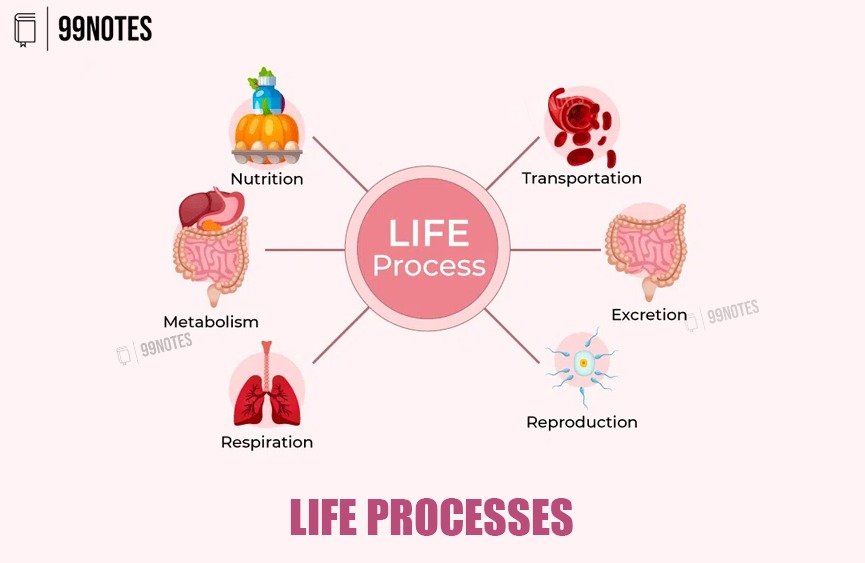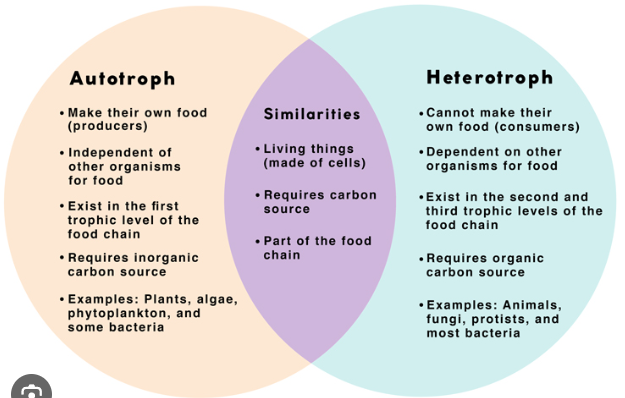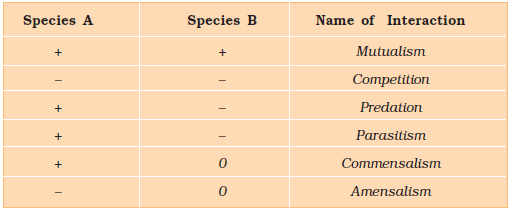Life Processes
Life Process refers to a series of Actions that are essential to determine if an animal is alive. These are movement, reproduction, sensitivity, nutrition, excretion, respiration and growth (MRS GREN).
- These processes are essential to sustain life. They do the job of maintaining cells/organisms.
- Variegated leaves: yellowing of leaves naturally: parts of leaves contain chlorophyll parts don’t.
We have already understood in a previous chapter that all living organisms feature the following life processes: They absorb/eat/ or make food; They grow, respire, Respond to stimuli, Excrete waste, reproduce, and move (in plants, minerals, nutrients move).
|
Are Viruses Alive? |
| Molecular movement is necessary for life. Viruses do not show any molecular movement in them until they infect some cells. There is controversy about whether they are truly alive or not. |
Nutrition
Nutrition is the process by which organisms take in and utilize food and nutrients to support growth, energy production, and overall bodily functions. Depending on how the organism avails nutrition, it can be classified into producers, consumers and decomposers.
Autotrophs
Autotrophs (or Producers) make their own food from simple substances. It includes all green plants.
- Making food in plants: Photosynthesis. Chlorophyll uses Water and CO2 to synthesise carbohydrates, in the presence of sunlight.
- Nitrogen in soil is converted by bacteria called Rhizobium, absorbed by roots. Fertilizers are N-rich. After each harvest amount of nitrogen in the soil falls. Rhizobium lives in the roots of gram, peas, moong, beans and other legumes. Takes shelter and provides nitrogen.
- Rhizobium and roots have a symbiotic relationship.
Heterotrophs:
Animals and most other organisms take ready food presented by plants. These are known as the consumers or heterotrophs. Consumers are generally classified as the Primary, Secondary and Tertiary:
- Primary consumers include herbivorous animals: goats, deer, mice etc.
- Secondary consumers Carnivores: flesh-eating mammals: snakes, tigers and lions.
- Tertiary consumers: These include consumers who are not consumed by others.
- Top Carnivores: Certain carnivores feed on Carnivores: Hawks and mongooses, man.
- Scavengers, such as Vultures and crows which consume the bodies of other dead consumers are also classified as tertiary Consumers.
Certain other types of consumers cannot fit into the above category:
4. Parasitism is another source of nutrition: As in Cuscuta, which is a parasite that climbs on the host plants to absorb nutrients. The pitcher eats insects. These can be both herbivores or carnivores.
Decomposers:
Decomposers feed on dead organisms:
- Decomposing agents: Bacteria and various micro-organisms. Turn into substances such as nutrients, and organic and inorganic salts essential for soil fertility.
- They are also known as the Saprotrophs: [sapro: decompose/degrade]. Saprotrophs take nutrition from dead and decaying matter in the form of solution (saprotrophic nutrition), For example, Fungi secrete digestive juices on dead/decaying matter and absorb the solution thus produced. Fungal spores are generally present in the air, when land on wet warm things, they germinate.
Symbiotic relationship:
When the relationship between the members of a community is mutually benefitial for each of the partners, it is known as the symbiotic relationship or Mutualism. Often such organisms live together and share nutrients. For example:
- Some Fungi live in roots and absorb nutrients, and in return help in absorbing water and nutrients from the soil. This is an important association.
- Lichens: Lichen refers to a community of Algae and fungi. Fungi provide shelter, water and minerals; Alga, the chlorophyll-containing partner of fungi, provides carbohydrates and oxygen that it prepares by photosynthesis.
- Corals: Corals are calcareous marine invertebrates. Each coral is composed of thousands of polyps which live together in a colony, which grows when polyps multiply to make copies of themselves. These polyps live in a symbiotic relationship with zooxanthellae Algae, the chlorophyll containing organisms, which imparts colour to the colony.
- The Algae convert sun’s energy to create oxygen and carbohydrates for the colony.
- In return, corals provide shelter to the Algae and key nutrients.
- Rhizobium Bacteria lives in a symbiotic relationship with Plants. The Rhizobium generally lives in root nodules of leguminous plants such as beans and peas. In this relationship, the Nitrogen in soil is converted by the Rhizobium bacteria, into forms that can get absorbed by the plantroots. Fertilizers are N rich. After each harvest amount of nitrogen in soil falls. Rhizobium lives in roots of gram, peas, moong, beans and other legumes. Takes shelter provides nitrogen.
- Rizobium and roots have symbiotic relationship.
Nutrition in Animals
Digestion in Humans: 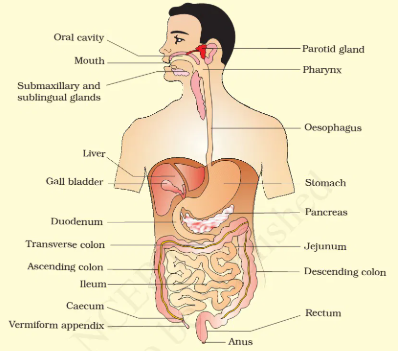
In Humnas, digestion occurs in the alimentary canal, which is a continuous tube running from the mouth to the anus, responsible for digestion and absorption. It includes the mouth, oesophagus, stomach, small intestine, large intestine, rectum, and anus. Digestive enzymes break down food, and nutrients are absorbed into the bloodstream for energy and growth.:
Buccal cavity:
- Ingestion takes place here and contains teeth each in a separate socket.
- Salivary glands: Saliva (which contains an enzyme named amylase) breaks starch into sugars.
- The tongue has taste buds.
Oesophagus:
Food is pushed down by the movement of the wall through peristaltic contractions. Exception: Vomit.
Stomach:
Thick-walled bag flattened-U shape, the inner lining of the stomach secretes mucous, hydrochloric acid (HCl) and digestive juices. Protein breaks into simpler substances. This acid plays a crucial role in digestion by breaking down food, activating digestive enzymes, and killing harmful microorganisms. The stomach’s acidic environment typically has a pH between 1.5 and 3.5, making it highly acidic.
- When the pH level of the stomach drops lower than the normal pH of about 1.5, it causes excessive acidity. This can lead to conditions like acid reflux or gastroesophageal reflux disease (GERD), where stomach acid moves up into the oesophagus, causing discomfort or heartburn.
- On the other hand, insufficient stomach acid can impair digestion, leading to symptoms such as bloating, indigestion, or nutrient deficiencies.
- To maintain healthy stomach acidity, it’s important to avoid overeating, manage stress, and eat balanced meals.
- In some cases, antacids or medications that reduce stomach acid may be used to treat high acidity or related conditions.
Peptic Ulcers: |
Causes acidity-related pain & bleeding in the stomach & duodenum(1st part of small intestine).
|
Small intestine:
It is a 7.5m long tube, that receives secretions from the liver and pancreas, its wall also secretes juices.
- Liver: It is a reddish brown gland, situated in the upper part of the abdomen on the right side, that secretes bile juice stored in the gall bladder, which helps in the digestion of fats.
- Pancreas: Large cream-coloured gland, just below the stomach; Juice acts on carbohydrates, fats, and proteins and changes into a simpler form.
- Intestinal juices complete the full digestion of all components of food. To make sugar as glucose, fats into fatty acids and glycerol, and proteins into amino acids.
- Digested food gets absorbed by thousands of finger-like outgrowths called villi. Each villus has a network of thin and small blood vessels close to its surface, which transport food in various organs, where complex substances such as protein are built: Process assimilation.
Large intestine:
It is 1.5m in length and absorbs water and some salts from undigested food material, the remaining waste remains semi-solid in the rectum. The remaining undigested product is excreted through the Anus.
Grass-Eating Animal:
Animals such as cattle, sheep and goats eat grass which is rich in cellulose. Many animals including humans can’t eat cellulose. These grazing animals have developed a unique mechanism to digest sugars present in cellulose.
- They quickly swallow grass and store it in part of the 4-chambered stomach called the Rumen (between the oesophagus and small intestine).
- Partially digested food forms a tiny ball-like structure called cud. It later returns to the mouth in small lumps and animals chew it. This process is known as the Rumination.
- Bacteria in the rumen play a vital role in digestion by breaking down cellulose and starch. The microbes too are digested and absorbed in the small intestine, providing up to 70–90% of a cow’s protein requirements.
- Such animals are referred to as the Ruminant.
Digestion in Amoeba: 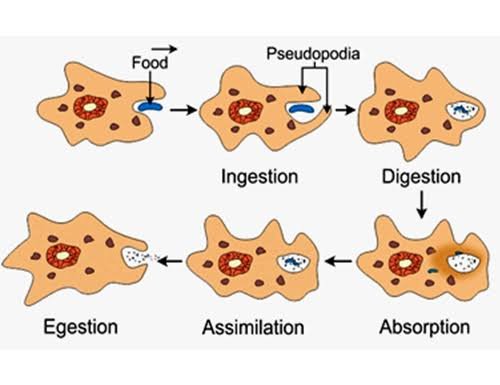
- Amoeba is generally found in pond water. It has bubble-like vacuoles in the cytoplasm.
- It changes shape to push a finger-like projection called pseudopodia (pseudo-false; Podia-feet) or false movement to capture food when it senses it. Food gets trapped in food vacuoles.
- Digestive juices break food in vacuoles and absorb it and the undigested food is expelled.
Respiration in Organisms
Respiration is the process of the breakdown of food in the cell with the release of energy in the cells. This release of energy can take place through two pathways:
- Aerobic respiration: Glucose breakdown with the help of Oxygen. -> CO2 + Water + Energy.
- Anaerobic: Glucose -(without O2)> Alcohol + CO2 + Energy.
- Muscle cells can respire anaerobically for a short time: Glucose -> Lactic acid+ Energy.
- During craps: Hot water massage improves circulation of blood in the body. As a result supply of Oxygen to muscles increases.
| Feature | Aerobic Respiration | Anaerobic Respiration |
| Definition | The process of energy production using oxygen. | Energy production without the use of oxygen. |
| End Products | Carbon dioxide (CO₂) and water (H₂O). | Lactic acid (in animals) or ethanol and CO₂ (in yeast). |
| Energy Produced | Produces 36-38 ATP molecules per glucose molecule. | Produces 2 ATP molecules per glucose molecule. |
| Oxygen Requirement | Requires oxygen. | Does not require oxygen. |
| Oxidation | Complete oxidation of glucose to CO₂ and H₂O. | Partial oxidation of glucose to lactic acid or ethanol. |
| Location in Cell | Occurs in mitochondria. | Occurs in the cytoplasm. |
| Efficiency | Highly efficient, and yields more energy per glucose molecule. | Less efficient |
Respiration in Animals
Breathing: It consists of Inhalation, which is the process of taking in the air( which is oxygen rich)), and Exhalation (giving out air rich in CO2).
- Inhalation: ribs move up and outwards, the diaphragm moves down, and more space in the chest cavity. Air = 21% O2 & 0.04% CO2.
- Exhalation: Ribs move in and down. The diaphragm moves up. Chest cavity reduces to push air out. Air =16.4% O2 & 4.4% CO2.
Air through the nostrils passes to the nasal cavity. Reaches to lungs through the windpipe, through windpipe in the chest cavity, surrounded by ribs on all sides. The muscular floor of the diaphragm forms the floor of the chest cavity. Breathing involves the movement of the diaphragm & rib cage.
- Breathing rate: No. Of time a person breathes in a minute. In an adult Human, breathing rate lies in the range of 12 to 20 per minute. In an infant, it is in the range of 30-60.
Respiration without Lungs: 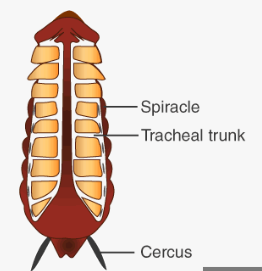
- Cockroach (insects): small openings on the sides of its body, called spiracles (analogous to nose). Insects have a network of air tubes called tracheae (analogous to lungs) for gas exchange. Oxygen-rich air diffuses into body tissue and reaches every cell of the body. These set of mechanisms are unique to insects.
- Earthworms: Breathe through skin, that feels moist and slimy on touching. Gases can easily pass through them.
- Frogs: They have a pair of lungs, and can also breathe through skin, which is moist & slippery.
- Fishes (breathing underwater): Gills (projections on the skin), which are well supplied with blood vessels for the exchange of gases.
Respiration in plants:
- Don’t breathe but respire to produce energy.
- Their cells take O2, which they produce themselves. Roots do not have chlorophyll, they take up air from air spaces present in soil particles.
Transportation
Animals have a circulatory system, in which the Blood transports everything, including digested food, waste, oxygen etc. It has plasma and everything is suspended/dissolved in it. This is pumped by a muscular heart throughout the body.
The Circulatory System in Humans
The Blood
In Humans, blood acts as the connective tissue consisting of fluid called plasma in which cells are suspended. It transports food, CO2 and nitrogenous waste in dissolved form. Oxygen is carried by RBC. Many substances like salts, are transported by blood. 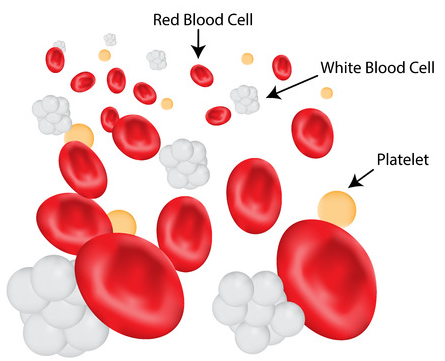
The blood is mainly composed of three types of cells:
- Red Blood Cells (RBCs): These are the blood cells that contain a red-pigmented protein called Haemoglobin which contains iron ions that bind O2 with it. This acts as a carrier of oxygen throughout the body. Parts ofO2
- White Blood Cells (WBCs): The WBCs fight against the germs. We will learn about them in the later chapters.
- Platelets: Platelets are small colourless cells that help in clot formation, ensuring that no blood leaks out of the circulatory system.
The Heart:
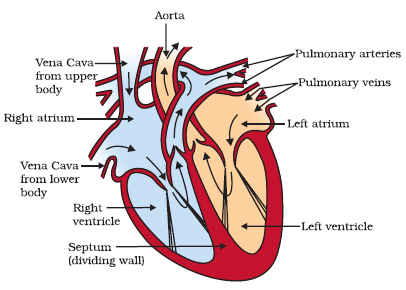 The human heart is a muscular organ that pumps blood throughout the body, maintaining blood circulation and supporting overall body functions.
The human heart is a muscular organ that pumps blood throughout the body, maintaining blood circulation and supporting overall body functions.
It is the size of a human fist and has four chambers: two atria and two ventricles.
The two atria, i.e. the right atrium and the left atrium, are located in the upper part of the heart.
The two ventricles (right and left) are located in the lower part of the heart, as shown in the figure. The ventricles are places where the pumping takes place and therefore are more muscular, having thicker walls.
- Systole is the action of simultaneous Contraction of both ventricles. This action pumps the blood with a thrust into the arteries. The valves in the heart guarantee that there is no backward circulation.
- Diastole is the phase of relaxation of the muscles in the cardiac cycle. During this phase, the blood fills into the heart, and the ventricles get filled again.
The Cardiac Cycle
- The Oxygen-rich blood from the lungs enters the heart through the Pulmonary veins to the left atrium. From there, the blood enters into the left ventricle, the strongest chamber of the heart.
- During the systolic contraction, the oxygenated blood is pumped via the Aorta to the other arteries and then to the whole body. It reaches to each living human cell via tiny blood capillaries.
- The cells load up the blood with carbon dioxide and other waste products, taking away the oxygen. This is carried via the capillaries, to the veins and ultimately to the heart.
- The deoxygenated blood enters via the right atrium to the Right Ventricle. It is then pumped via the pulmonary veins to the Lungs.
Remember it this way:
- Arteries are vessels that take blood from the heart, either to the body (oxygenated) or to the lungs (deoxygenated). These are stronger as the heart pumps blood into them with full force.
- Veins are the vessels that bring blood to the heart, either from the body (deoxygenated) or from the lungs (oxygenated).
- The term Pulmonary is related to Lungs.
- Therefore pulmonary arteries would take blood from the heart and to the lungs. Can you guess which type of blood would be taken to the lungs from the heart?
- Similarly, pulmonary veins would bring oxygenated blood to the heart.
- The Oxygenated blood is pumped into the body, while deoxygenated blood is sent to the lungs for oxygenation.
Blood Vessels:
In a nutshell, the circulatory system consists of two types of vessels: 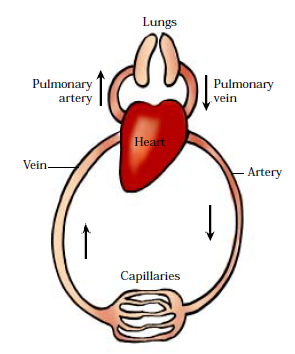
- Arteries: Blood vessels that take blood from the heart:
- Heart to lung = pulmonary arteries. These take deoxygenated blood for oxygenation.
- Heart to capillaries = Arteries such as the Aorta take Oxygenated blood to the cells.
- Veins: Blood vessels that bring blood to the heart:
- Lung to heart = pulmonary These carry oxygenated blood to the hearth for pumping;
- Capillaries to heart = Veins like Vena Cava etc. carry deoxygenated blood from the cells to the heart.
Since blood emerges with high blood pressure, arteries have thick, elastic walls. Veins do not need a thick wall due to low pressure. Instead, since the blood is not pushed by the heart in the veins, it needs to be broader to ensure blood flow.
On reaching tissues, the arteries and veins divide into smaller vessels (arterioles and venules) to bring blood in contact with all individual cells. These are the smallest vessels in the human body, known as the Blood Capillaries.
They enable the exchange of oxygen, nutrients, and waste products between the blood and surrounding tissues. Their thin walls allow for efficient diffusion, playing a critical role in maintaining tissue health and fluid balance.
They then join again to form veins.
Maintenance by platelets:
- When the blood vessels leak, and in situations when injured stars bleeding. If the loss of blood is minimised it can severely reduce the pressure. This in turn can reduce the efficiency of the pumping system, and cells might start dying due to the inadequate supply of oxygen.
- The whole system is safeguarded by the action of the platelets.
- Platelets circulate around the body and plug these leaks by helping to clot the blood at the points of injury.
| Blood Pressure |
Blood Pressure refers to the force exerted by circulating blood on the walls of blood vessels. It is essential for ensuring that blood reaches all parts of the body. Blood pressure is typically measured in millimetres of mercury (mmHg) and recorded as two numbers:
Normal blood pressure is generally considered to be around 120/80 mmHg. Measuring Blood Pressure Using a Stethoscope and SphygmomanometerA sphygmomanometer is a device used to measure blood pressure, consisting of an inflatable cuff, a pressure gauge, and a bulb for inflation. To measure the blood pressure, the cuff is tightly placed around the upper arm and the stethoscope’s diaphragm is placed over the elbow’s inner crease. The cuff is then inflated and its pressure is slowly released. Now, Listen for Korotkoff Sounds:
|
Double Circulation:
Blood passes twice through the heart in a cycle. Thick separation between right side & left side chambers allows a highly efficient supply of Oxygen (no mixing of blood). 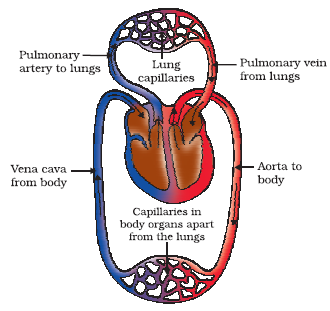
Warm–blooded animals need fresh warm blood to maintain body temperature, and therefore they have this double circulation system in the body.
Most Cold-blooded animals, which are mainly Amphibians or reptiles have a 3-chambered heart. This means some of the oxygenated and deoxygenated blood mixes. However since the amphibians have a lower energy requirement, they can tolerate some intermixing of blood. This still is a double circulatory system.
Crocodiles and alligators are the only amphibian exceptions having 4-chambered hearts.
Single circulation
Fishes have 2 chambered hearts. It is a single circulation cycle in which blood is pumped only by the heart in a cycle. The Blood is pumped to the gills, and oxygenated blood directly to the rest of the body.
Lymph:
Lymph or tissue fluid is another transportation fluid in our body. Through pores present in the walls of capillaries some amount of plasma, protein and blood cells escape into the intercellular spaces and form lymph.
It is similar to plasma of blood but colourless and contains less protein.
Lymph carries digested and absorbed fat from the intestine and drains excess fluid from extracellular space back to blood.
Excretion:
Each cell of our body dumps its wastes outside the cells which is carried out by our blood capillaries into the blood vessels.
- Blood takes waste to the kidneys: Useful substances are absorbed back, and waste forms urine. It goes to the urinary bladder via a narrow tube called the ureter.
- A muscular tube called the urethra controls the opening to expel urine out.
- The adult body produces 1-1.8L of urine daily: 95% of it is water, 2.5% Urea, and 2.5% other waste such as uric acid, ammonia, and electrolytes.
| Dialysis – Making artificial kidneys; |
Humans can run without kidneys for a few days. However, the accumulation of waste in the body can quickly become toxic and start harming the cells. In such a case, dialysis is done.
|
Transport in Plants:
The transportation system in Plants consists of the Root system, trunk (having Xylem and Phloem), stems and leaves.
Roots:
Root hair absorbs water with mineral dissolved and can also dump nitrogenous waste into the soil. They are of two types:
- The main roots are called ‘Tap roots’, and smaller roots are called lateral roots.
- Where all roots are the same, we call them Fibrous roots.
Xylem and Phloem
- Transported by a network of Vascular tissue made of special cells, called Xylem, to leaves. Continuous transpiration creates a suction pull. This can pull water to great heights. However, through Xylem the material can move only upwards.
- In Phloem, which has perforated walls, material can move in both directions. The phloem transports food from leaves to other parts of the plant. Except for phloem fibres phloem cells are living cells.
Leaves:
Parts of a Leaf:
- Petiole: part of leaves attached to the stem.
- Lamina: green part of the leaf.
- Veins of the leaf are of 2 types: Midrib & leaf venation(design made by veins).
- Venation itself is of 2 types:
- Reticulate venation: Net-like on both sides of the midrib
- Parallel venation: Like in grass. Parallel veins.
- Transpiration: water evaporates from the openings of the stomata on leaves, while the exchange of gases takes place. This evapotranspiration loss creates a transpirational pull. This pull is the main force behind the transportation through Xylem tubes.
Body Movements
Movement in Humans: 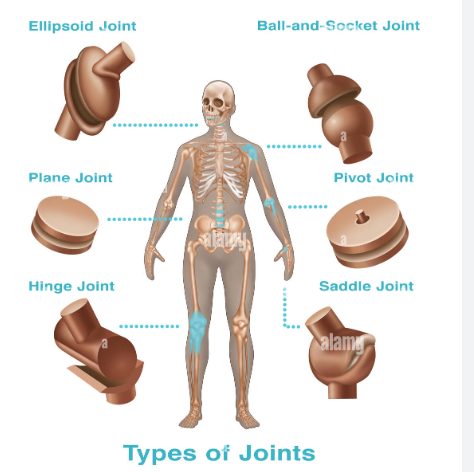
- Ball socket Joint: The rounded end of one of its bones fits into the cavity of the other bone. Hand from shoulders.
- Pivotal Joint: A cylindrical bone rotates in a ring. Head & Neck.
- Hinge Joint: Like a ball socket but only one direction of movement. Elbow, knee bone to lower part of leg.
- Fixed Joint: Do not move: Rib cage wrt backbone.
- Special bones:
-
- Pelvic bones: at the waist.
- Cartilage: soft bones. Can twist and bend. Ears.
Gait in Insects
The Gait refers to the movement pattern of insects.
- Earthworm: no bones: move by muscle contraction and expansion.
- Snail: Has shell on back, thick structure on foot made of strong muscles.
- Cockroach: Body made of hard outer skeleton- exoskeleton. The leg is made of 3 parts. Muscles help in walking.
- Birds: Bones are hollow and light. Bones of hind limbs for walking & perching. Fore-limbs are modified as wings. Breastbones are modified to hold muscles.
- Fish streamlined body, a skeleton covered with strong muscles. For movement muscles make the body curve on one side & tail part of the body on the other side. Fins are mainly to help in maintaining balance.
- Snake: has a long backbone, and many thin muscles connected with each other, even though they are far apart. Also interconnected are the backbone, ribs & skin.
Living Organisms & surroundings:
- Adaptation: Presence of specific features or certain habits, that enable a plant/animal to live in its surroundings.
- Habitat: surrounding where organisms live.
- Terrestrial Habitat: Plants/animals live on land. This is a terrestrial habitat.
- Aquatic habitat: Habitat in water.
- Biotic Components: Plants/Animals are biotic components of the habitat.
- Non-biotic components: Other non-living things are abiotic components.
Terrestrial Habitat:
- Desert: Animals like rats, and snakes not having long legs stay in deep burrows in sand.
- Come out at night. Plants’ leaves reduce to spine, to reduce transpiration. Photosynthesis is carried by stems, which are covered with a thin waxy layer, which helps to retain water. Roots go deep into the soil for water.
- Mountain region: Trees have sloping branches, leaves of some of the trees are needle-like.
- Animals have thick skin with fur. For example, Yaks have long hair including on the feet and toes.
- Grasslands: Play of prey and Predators.
- Forest Ecosystem: A Forest is a “Dynamic living entity” that continuously recycles nutrients utilising the sun’s energy.
- Herbs: Plants with Green & tender stems are called herbs, short, not have many branches. For example, Grass, wheat, and maize.
- Shrubs: Plants have stems branching out near the base: hard but not very thick. For example, Rose and Tulsi.
- Trees: very tall, hard, brown, thick stem. Have branches in the upper part.
- Crown: Branchy part of the tree above stems;
- Canopy: The roof of the forest is made of dense leaves & branches.
- Creepers: weak stems can’t stand upright.
- Climbers: take support of supporting structures.
- Humus: a dark-coloured substance produced after the decomposition of dead plants/animals by the decomposers; It is Rich in nutrients.
Aquatic habitat:
- Oceans: Streamline shape, (exceptions: Octopus), gills to use oxygen(Dolphins and whales breathe through nostrils or blowholes located on the upper part of the head, come out of the surface from time to time to breathe).
Ponds& lakes: Plants: roots have the main job of holding the plant in place. Stems are long hollow & light. Some plants are totally submerged in water. Some have narrow ribbon-like leaves. Can bend in flowing water.

